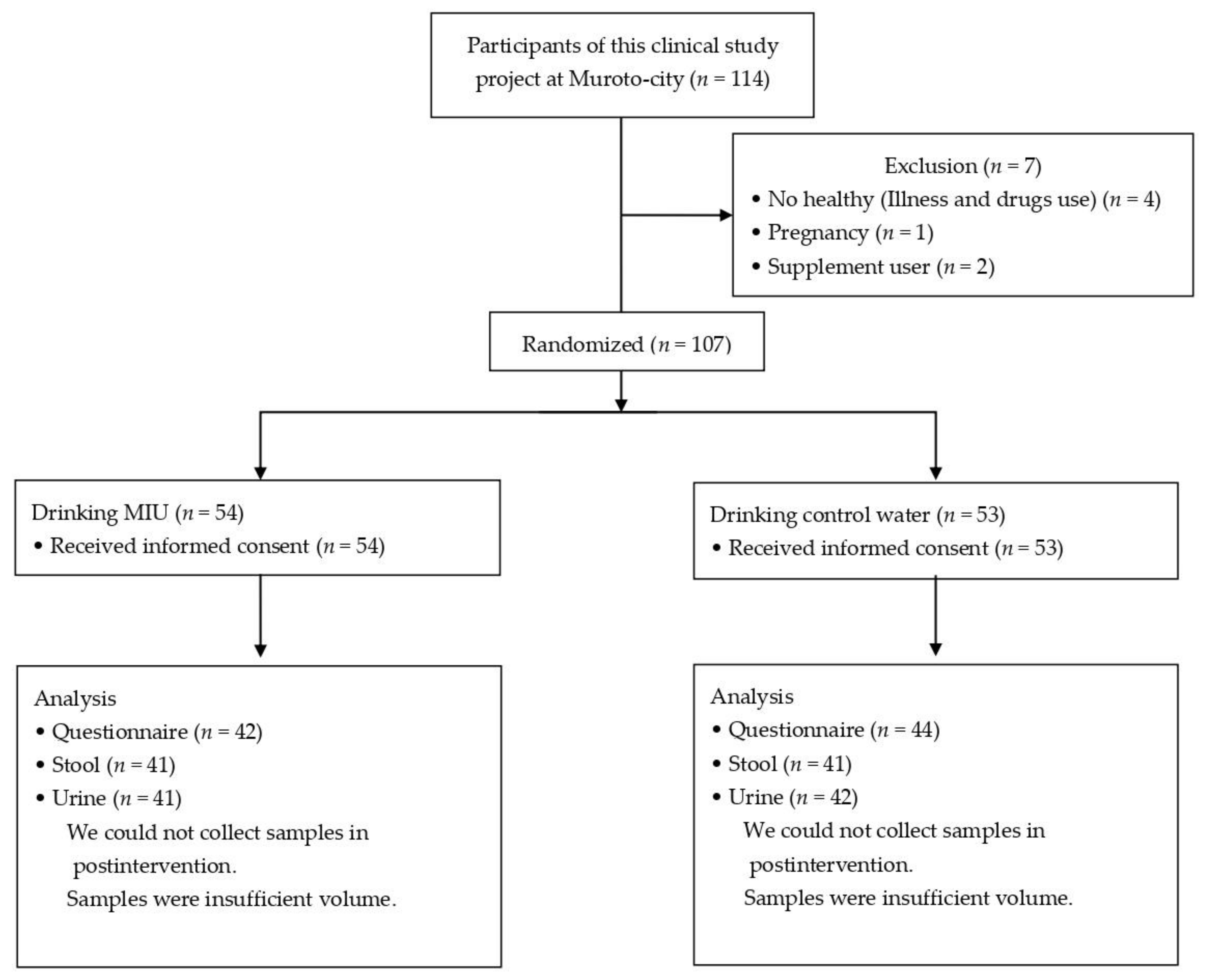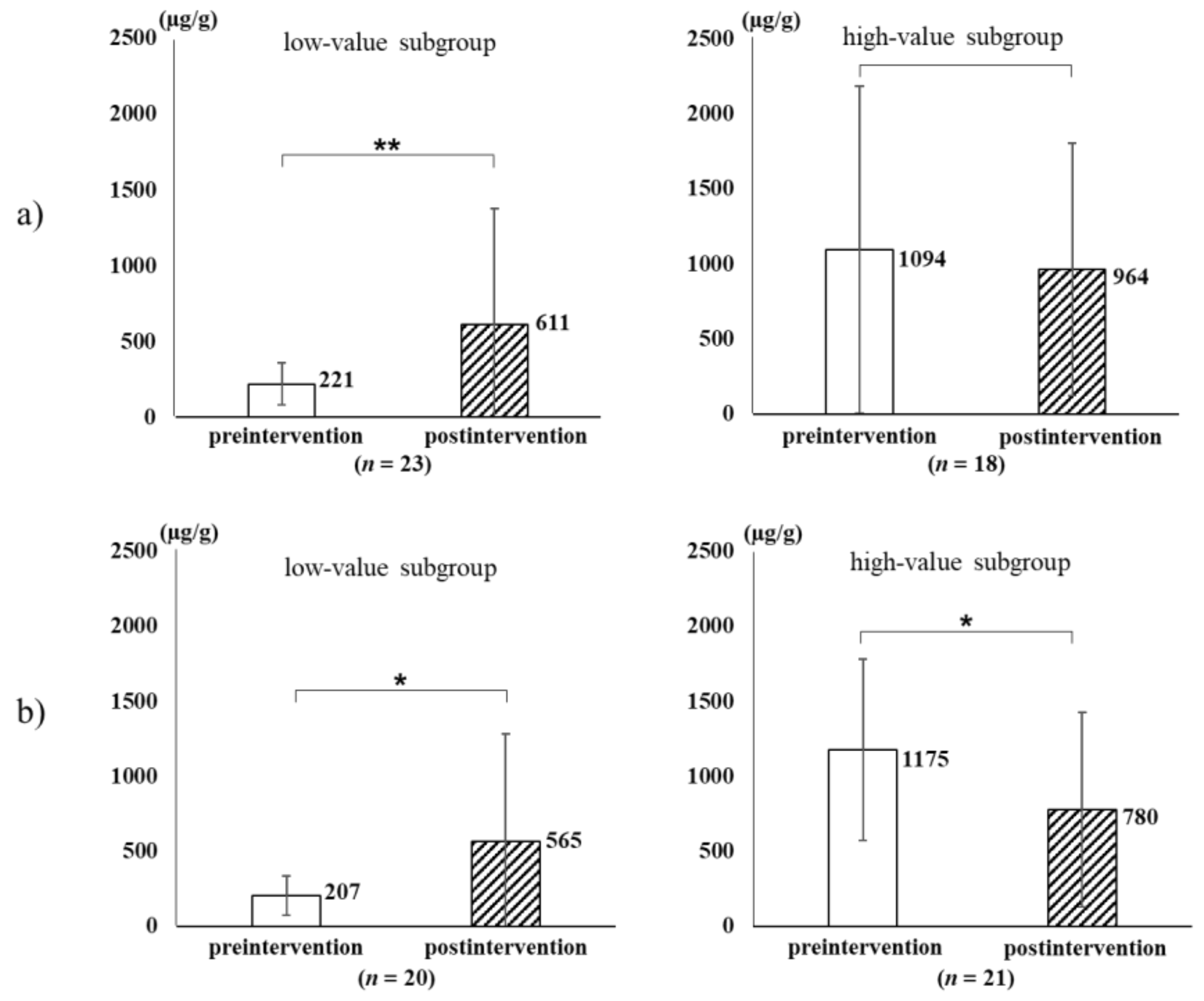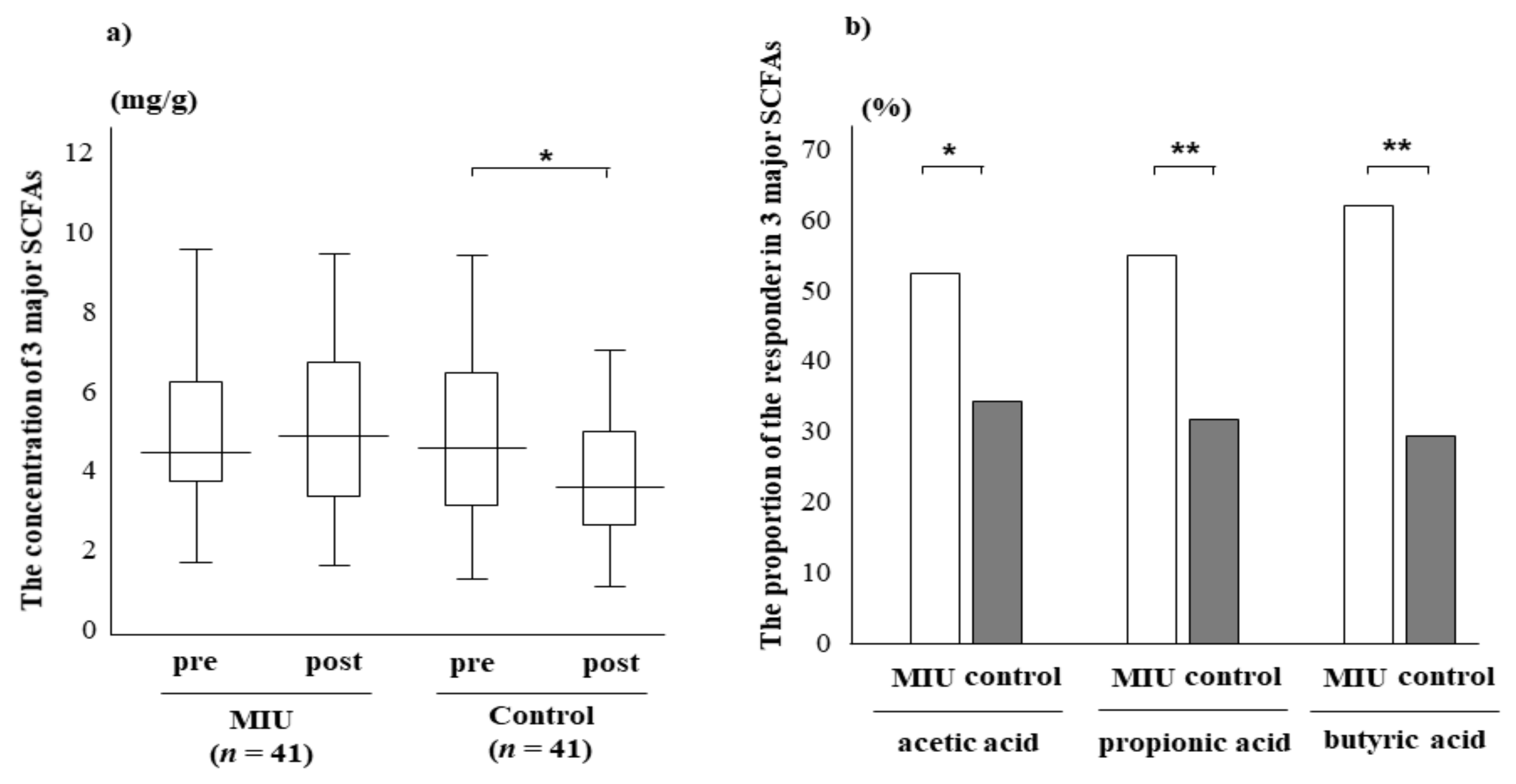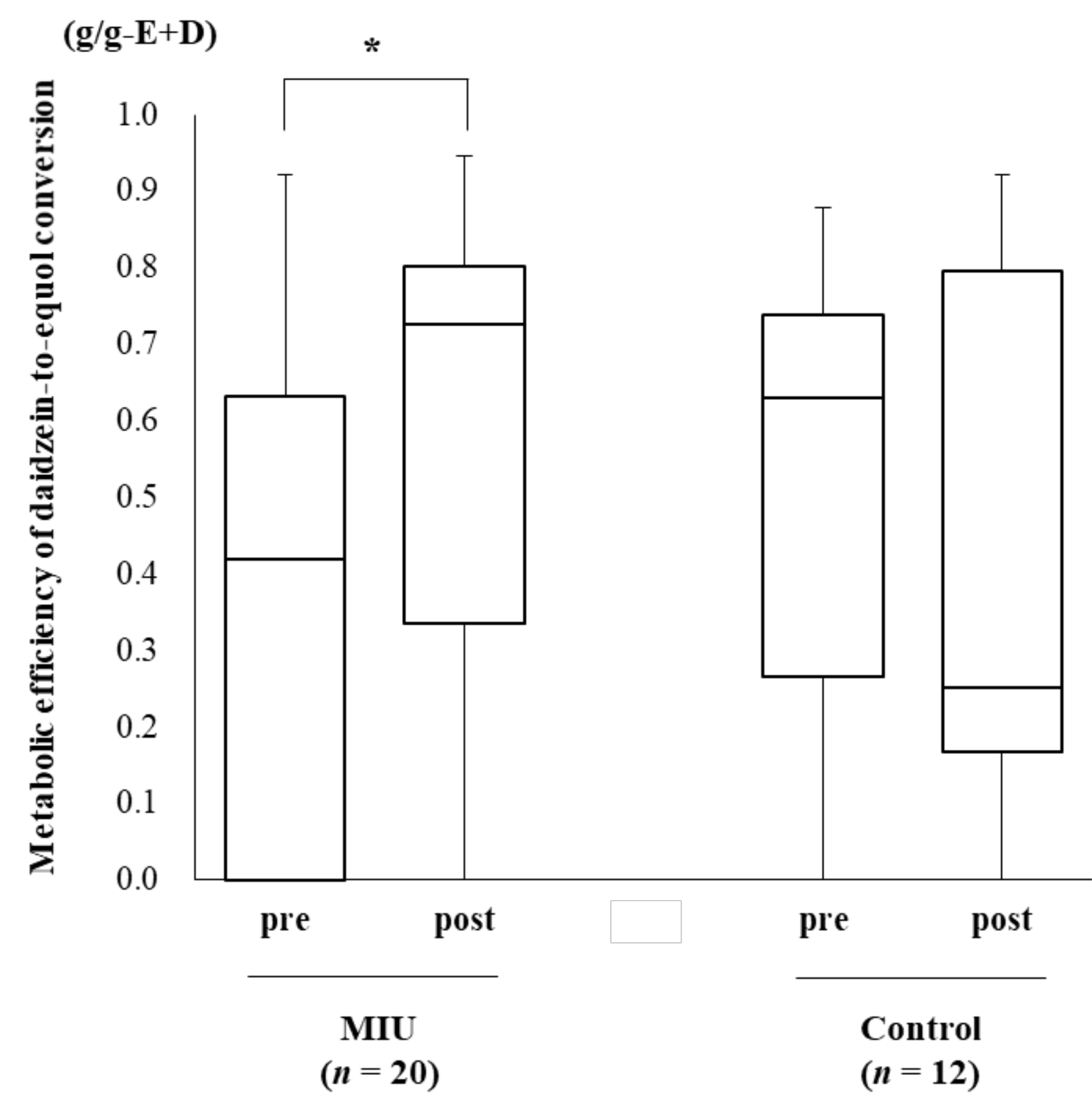Health Effects of Drinking Water Produced from Deep Sea Water: A Randomized Double-Blind Controlled Trial
Abstract
1. Introduction
2. Materials and Methods
2.1. Clinical Study Design
2.2. Participants
2.3. Ingestion Schedule
2.4. Evaluation
2.5. Self-Administered Questionnaire
2.6. Measurement of Fecal and Urine Samples
2.6.1. Fecal sIgA
2.6.2. Fecal Putrefactive Products
2.6.3. Analysis of Intestinal Microbiota
2.6.4. Urinary Isoflavones
2.7. Statistical Analysis
3. Results
3.1. Self-Administered Questionnaire
3.2. Analysis of Fecal sIgA, Putrefactive Products, and SCFAs
3.3. Analysis of Urinary Isoflavones
3.4. Analysis of Fecal Microbiota in Equol Producers
4. Discussion
5. Conclusions
Supplementary Materials
Author Contributions
Funding
Institutional Review Board Statement
Informed Consent Statement
Acknowledgments
Conflicts of Interest
References
- Gao, C.; Zhang, Y.; Wu, D.; Ma, L.; Zhang, Y.; Zhang, Q.; Huang, X. Development Status and Prospects of Deep Seawater Comprehensive Utilization Industry. IOP Conf. Ser. Earth Environ. Sci. 2019, 384, 012030. [Google Scholar] [CrossRef]
- Nani, S.Z.M.; Majid, F.A.A.; Jaafar, A.B.; Mahdzir, A.; Musa, M.N. Potential Health Benefits of Deep Sea Water: A Review. Evid. Based Complementary Altern. Med. 2016, 2016, 6520475. [Google Scholar] [CrossRef]
- Yoshioka, S.; Hamada, A.; Cui, T.; Yokota, J.; Yamamoto, S.; Kusunose, M.; Miyamura, M.; Kyotani, S.; Kaneda, R.; Tsutsumi, Y.; et al. Pharmacological Activity of Deep-Sea Water: Examination of Hyperlipemia Prevention and Medical Treatment Effect. Biol. Pharm. Bull. 2003, 26, 1552–1559. [Google Scholar] [CrossRef] [PubMed]
- Nagai, N.; Ito, Y. Delay of cataract development in the Shumiya cataract rat by water containing enhanced concentrations of magnesium and calcium. Curr. Eye Res. 2007, 32, 439–445. [Google Scholar] [CrossRef] [PubMed]
- Ha, B.G.; Park, J.E.; Shin, E.J.; Shon, Y.H. Effects of Balanced Deep-Sea Water on Adipocyte Hypertrophy and Liver Steatosis in High-Fat, Diet-Induced Obese Mice. Obesity 2014, 22, 1669–1678. [Google Scholar] [CrossRef] [PubMed]
- Yang, C.C.; Yao, C.A.; Lin, Y.R.; Yang, J.C.; Chien, C.T. Deep-Sea Water Containing Selenium Provides Intestinal Protection against Duodenal Ulcers through the Upregulation of Bcl-2 and Thioredoxin Reductase 1. PLoS ONE 2014, 9, e96006. [Google Scholar] [CrossRef][Green Version]
- Kimata, H.; Tai, H.; Nakajima, H. Reduction of allergic skin responses and serum allergen-specific IgE and IgE-inducing cytokines by drinking deep-sea water in patients with allergic Rhinitis. Otorhinolaryngol. Nova 2001, 11, 302–303. [Google Scholar] [CrossRef]
- Kimata, H.; Tai, H.; Nakagawa, K.; Yokoyama, Y.; Nakajima, H.; Ikegami, Y. Improvement of skin symptoms and mineral imbalance by drinking deep sea water in patients with atopic eczema/dermatitis syndrome (AEDS). Acta Med. 2002, 45, 83–84. [Google Scholar] [CrossRef]
- Hataguchi, Y.; Tai, H.; Nakajima, H.; Kimata, H. Drinking deep-sea water restores mineral imbalance in atopic eczema/dermatitis syndrome. Eur. J. Clin. Nutr. 2005, 59, 1093–1096. [Google Scholar] [CrossRef]
- Kawada, M.; Takeuchi, H.; Con, S.A.; Yamamoto, E.; Yasukawa, T.; Nakagawa, K.; Ikegami, Y.; Sugiura, T. Antibacterial activity of refined deep seawater on Helicobacter pylori. J. Med. Microbiol. Diagn. 2012, S1, 2. [Google Scholar] [CrossRef]
- Takeuchi, H.; Trang, V.T.; Morimoto, N.; Nishida, Y.; Matsumura, Y.; Sugiura, T. Natural products and food components with anti-Helicobacter pylori activities. World J. Gastroenterol. 2014, 20, 8971–8978. [Google Scholar] [CrossRef]
- Takeuchi, H.; Higuchi, K.; Yoshikane, Y.; Takagi, R.; Tokuhiro, S.; Takenaka, K.; Oboshi, W.; Kimura, A.; Islam, J.; Kaneko, A.; et al. Drinking Refined Deep-Sea Water Improves the Gut Ecosystem with Beneficial Effects on Intestinal Health in Humans: A Randomized Double-Blind Controlled Trial. Nutrients 2020, 12, 2646. [Google Scholar] [CrossRef]
- Clemente, J.C.; Ursell, L.K.; Parfrey, L.W.; Knight, R. The Impact of the Gut Microbiota on Human Health: An Integrative View. Cell 2012, 148, 1258–1270. [Google Scholar] [CrossRef]
- Donovan, S.M. Introduction to the special focus issue on the impact of diet on gut microbiota composition and function and future opportunities for nutritional modulation of the gut microbiome to improve human health. Gut Microbes 2017, 8, 75–81. [Google Scholar] [CrossRef]
- Galland, L. The Gut Microbiome and the Brain. J. Med. Food 2014, 17, 1261–1272. [Google Scholar] [CrossRef]
- Cryan, J.F.; Dinan, T.G. Mind-altering microorganisms: The impact of the gut microbiota on brain and behaviour. Nat. Rev. Neurosci. 2012, 13, 701–712. [Google Scholar] [CrossRef]
- Rea, K.; O’Mahony, S.M.; Dinan, T.G.; Cryan, J.F. The Role of the Gastrointestinal Microbiota in Visceral Pain. Handb. Exp. Pharmacol. 2017, 239, 269–287. [Google Scholar]
- Liu, C.; Cheng, L.; Ji, L.; Li, F.; Zhan, Y.; Wu, B.; Ke, Y.; Chen, P.; Hua, F.; Yuan, L.; et al. Intestinal microbiota dysbiosis play a role in pathogenesis of patients with primary immune thrombocytopenia. Thromb. Res. 2020, 190, 11–19. [Google Scholar] [CrossRef]
- Chauhan, A.; Kumar, R.; Sharma, S.; Mahanta, M.; Vayuuru, S.K.; Nayak, B.; Kumar, S.; Shalimar. Fecal Microbiota Transplantation in Hepatitis B e Antigen-Positive Chronic Hepatitis B Patients: A Pilot Study. Dig. Dis. Sci. 2020, 66, 873–880. [Google Scholar] [CrossRef]
- Vrieze, A.; Van Nood, E.; Holleman, F.; Salojärvi, J.; Kootte, R.S.; Bartelsman, J.F.; Dallinga-Thie, G.M.; Ackermans, M.T.; Serlie, M.J.; Oozeer, R.; et al. Transfer of intestinal microbiota from lean donors increases insulin sensitivity in individuals with metabolic syndrome. Gastroenterology 2012, 143, 913–916. [Google Scholar] [CrossRef]
- Fond, G.B.; Lagier, J.C.; Honore, S.; Lancon, C.; Korchia, T.; Verville, P.S.; Llorca, P.M.; Auquier, P.; Guedj, E.; Boyer, L. Microbiota-Orientated Treatments for Major Depression and Schizophrenia. Nutrients 2020, 12, 1024. [Google Scholar] [CrossRef] [PubMed]
- Van Nood, E.; Vrieze, A.; Nieuwdorp, M.; Fuentes, S.; Zoetendal, E.G.; de Vos, W.M.; Visser, C.E.; Kuijper, E.J.; Bartelsman, J.F.; Tijssen, J.G.; et al. Duodenal infusion of donor feces for recurrent Clostridium difficile. N. Engl. J. Med. 2013, 368, 407–415. [Google Scholar] [CrossRef]
- Rossen, N.G.; MacDonald, J.K.; de Vries, E.M.; D’Haens, G.R.; de Vos, W.M.; Zoetendal, E.G.; Ponsioen, C.Y. Fecal microbiota transplantation as novel therapy in gastroenterology: A systematic review. World J. Gastroenterol. 2015, 2, 5359–5371. [Google Scholar] [CrossRef]
- Yamori, Y.; Moriguchi, E.H.; Teramoto, T.; Miura, A.; Fukui, Y.; Honda, K.I.; Fukui, M.; Nara, Y.; Taira, K.; Moriguchi, Y. Soybean isoflavones reduce postmenopausal bone resorption in female Japanese immigrants in Brazil: A ten-week study. J. Am. Coll. Nutr. 2002, 21, 560–563. [Google Scholar] [CrossRef] [PubMed]
- Messina, M.; Watanabe, S.; Setchell, K.D. Report on the 8th international symposium on the role of soy in health promotion and chronic disease prevention and treatment. J. Nutr. 2009, 139, 796S–802S. [Google Scholar] [CrossRef] [PubMed]
- Miura, A.; Sugiyama, C.; Sakakibara, H.; Simoi, K.; Goda, T. Bioavailability of isoflavones from soy products in equol producers and non-producers in Japanese women. J. Nutr. Intermed. Metab. 2016, 6, 41–47. [Google Scholar] [CrossRef]
- Lampe, J.W.; Chang, J.L. Inter individual differences in phytochemical metabolism and disposition. Semin. Cancer Biol. 2007, 17, 347–353. [Google Scholar] [CrossRef]
- Lampe, J.W. Interindividual differences in response to plant-based diets: Implications for cancer risk. Am. J. Clin. Nutr. 2009, 89, 1553S–1557S. [Google Scholar] [CrossRef]
- Takahashi, S.; Tomita, J.; Nishioka, K.; Hisada, T.; Nishijima, M. Development of a Prokaryotic Universal Primer for Simultaneous Analysis of Bacteria and Archaea Using Next-Generation Sequencing. PLoS ONE 2014, 9, e105592. [Google Scholar]
- Unno, T.; Hisada, T.; Takahashi, S. Hesperetin Modifies the Composition of Fecal Microbiota and Increases Cecal Levels of Short-Chain Fatty Acids in Rats. J. Agric. Food Chem. 2015, 63, 7952–7957. [Google Scholar] [CrossRef]
- Thompson, W.G.; Longstreth, G.F.; Drossman, D.A.; Heaton, K.W.; Irvine, E.J.; Müller-Lissner, S.A. Functional bowel disorders and functional abdominal pain. Gut 1999, 45 (Suppl. 2), II43–II47. [Google Scholar] [CrossRef]
- Tourlousse, D.M.; Narita, K.; Miura, T.; Sakamoto, M.; Ohashi, A.; Shiina, K.; Matsuda, M.; Miura, D.; Shimamura, M.; Ohyama, Y.; et al. Validation and standardization of DNA extraction and library construction methods for metagenomics-based human fecal microbiome measurements. Microbiome 2021, 9, 95. [Google Scholar] [CrossRef]
- Setchell, K.D.R.; Cole, S.J. Method of defining equol-producer status and its frequency among vegetarians. J. Nutr. 2006, 136, 2188–2193. [Google Scholar] [CrossRef]
- Mayo, B.; Vázquez, L.; Flórez, A.B. Equol: A Bacterial Metabolite from The Daidzein Isoflavone and Its Presumed Beneficial Health Effects. Review Nutrients 2019, 11, 2231. [Google Scholar] [CrossRef]
- Kwon, J.E.; Lim, J.; Kim, I.; Kim, D.; Kang, S.C. Isolation and identification of new bacterial stains producing equol from Pueraria lobata extract fermentation. PLoS ONE 2018, 15, e0192490. [Google Scholar] [CrossRef]
- Chakravarthy, S.K.; Jayasudha, R.; Prashanthi, G.S.; Ali, M.H.; Sharma, S.; Tyagi, M.; Shivaji, S. Dysbiosis in the gut bacterial microbiome of patients with uveitis, an inflammatory disease of the eye. Indian J. Microbiol. 2018, 58, 457–469. [Google Scholar] [CrossRef]
- Khattab, M.S.A.; Abd El Tawab, A.M.; Fouad, M.T. Isolation and characterization of anaerobic bacteria from frozen rumen liquid and its potential characterizations. Int. J. Dairy Sci. 2017, 12, 47–51. [Google Scholar] [CrossRef][Green Version]
- Liu, X.; Mao, B.; Gu, J.; Wu, J.; Cui, S.; Wang, G.; Zhao, J.; Zhang, H.; Chen, W. Blautia—a new functional genus with potential probiotic properties? Gut Microbes 2021, 13, 1875796. [Google Scholar] [CrossRef]
- Benitez-Paez, A.; Gomez, D.P.E.; Lopez-Almela, I.; Moya-Perez, A.; Codoner-Franch, P.; Sanz, Y. Depletion of Blautia species in the microbiota of obese children relates to intestinal inflammation and metabolic phenotype worsening. mSystems 2020, 5, 2. [Google Scholar] [CrossRef]
- Xie, H.; Hong, J.; Sharma, A.; Wang, B.Y. Streptococcus cristatus ArcA Interferes with Porphyromonas gingivalis Pathogenicity in Mice. J. Periodont. Res. 2012, 47, 578–583. [Google Scholar] [CrossRef]
- Ho, M.H.; Lamont, R.J.; Xie, H. Identification of Streptococcus cristatus peptides that repress expression of virulence genes in Porphyromonas gingivalis. Sci. Rep. 2017, 7, 1413. [Google Scholar] [CrossRef] [PubMed]
- Stegger, M.; Andersen, P.S.; Kearns, A.; Pichon, B.; Holmes, M.A.; Edwards, G.; Laurent, F.; Teale, C.; Skov, R.; Larsen, A.R. Rapid detection, differentiation and typing of methicillin-resistant Staphylococcus aureus harbouring either mecA or the new mecA homologue mecALGA251. Clin. Microbiol. Infect. 2012, 18, 395–400. [Google Scholar] [CrossRef] [PubMed]
- Hendrich, S. Bioavailability of isoflavones. J. Chromatogr. B 2002, 777, 203–210. [Google Scholar] [CrossRef]




| MIU | Mineral Water (Control) | |||||||||||
|---|---|---|---|---|---|---|---|---|---|---|---|---|
| Total (n = 41) | male (n = 17) | female (n = 24) | Total (n = 41) | male (n = 19) | female (n = 22) | |||||||
| Age (year) | 43 | (33–53) | 47 | (33–52) | 42.5 | (32–53) | 42 | (33–57) | 37 | (37–58) | 47 | (37–58) |
| BMI(Kg/m2) | 22.6 | (20.7–26.4) | 23.5 | (22.5–27.2) | 21.7 | (20.3–23.2) | 42 | (33–57) | 37 | (37–58) | 47 | (37–58) |
| 22.9 | (21.5–25.5) | 22.4 | (21.3–25.1) | 23.2 | (21.9–26.4) | |||||||
| sIgA (μg/g) | 408 | (209–651) | 394 | (202–538) | 492 | (207–678) | 555 | (169–1042) | 449 | (159–1016) | 614 | (21.9–26.4) |
| Putrefaction (μg/g) | ||||||||||||
| Phenol | 1.3 | (0.50–6.70) | 4.6 | (1.07–13.45) | 0.8 | (0.45–5.20) | 1.4 | (0.60–7.20) | 2 | (0.72–13.55) | 1.3 | (0.45–5.90) |
| p-Cresol | 28.2 | (9.15–69.45) | 19.7 | (6.00–65.50) | 40.7 | (10.07–81.30) | 59.2 | (21.20–90.98) | 57.4 | (23.80–111.42) | 60.65 | (19.70–78.90) |
| 4-Ethylphenol | 2.3 | (1.63–4.15) | 2.7 | N/A | 2.3 | N/A | 1.7 | (0.70–2.90) | 1.7 | (1.50–7.80) | 0.7 | (0.70–2.47) |
| Indol | 19.4 | (11.80–31.75) | 19.4 | (9.32–32.37) | 19.45 | (12.60–31.25) | 22.8 | (11.85–35.90) | 30.4 | (15.20–41.70) | 17.3 | (10.00–27.60) |
| Skatol | 2.75 | (1.20–7.80) | 2.8 | (1.27–7.02) | 2.7 | (0.57–12.12) | 4.8 | (1.35–10.00) | 2.7 | (0.09–0.24) | 5.8 | (1.40–10.00) |
| SCFA (mg/g) | ||||||||||||
| Succinic acid | 0.19 | (0.09–0.47) | 0.21 | (0.11–0.36) | 0.16 | (0.08–0.50) | 0.12 | (0.08–0.24) | 0.14 | N/A | 0.11 | (0.07–0.24) |
| Lactic acid | 0.19 | (0.08–0.68) | 0.23 | (0.13–0.82) | 0.12 | (0.07–0.44) | 0.11 | (0.08–0.17) | 0.08 | (0.07–0.15) | N/A | |
| Formic acid | N/A | N/A | N/A | N/A | N/A | N/A | ||||||
| Acetic acid | 3.19 | (1.85–4.03) | 2.72 | (1.65–3.77) | 3.27 | (2.16–4.04) | 2.63 | (1.97–3.37) | 2.63 | (1.90–3.65) | 2.59 | (1.99–3.69) |
| Propionic acid | 1.02 | (0.76–1.28) | 1.01 | (0.72–1.28) | 1.04 | (0.79–1.35) | 1.12 | (0.87–1.57) | 1.38 | (0.88–1.66) | 1.07 | (0.85–1.45) |
| Isobutyric acid | 0.16 | (0.12–0.20) | 0.19 | N/A | 0.13 | (0.11–0.19) | 0.15 | (0.13–0.19) | 0.17 | (0.130–0.21) | 0.14 | (0.130–0.155) |
| Butyric acid | 0.77 | (0.54–1.27) | 0.73 | (0.54–1.05) | 0.78 | (0.53–1.31) | 0.84 | (0.54–1.48) | 1.03 | (0.56–1.80) | 0.81 | (0.52–1.23) |
| 3-Methylbutanoic acid | 0.2 | (0.14–0.26) | 0.18 | (0.14–0.30) | 0.21 | (0.14–0.25) | 0.2 | (0.15–0.27) | 0.21 | (0.16–0.33) | 0.2 | (0.130–0.25) |
| Valeric acid | 0.21 | (0.13–0.31) | 0.25 | (0.18–0.30) | 0.18 | (0.12–0.32) | 0.17 | (0.14–0.29) | 0.22 | (0.18–0.38) | 0.15 | (0.13–0.20) |
| Urine Isoflavones | ||||||||||||
| Daidzein (mg/g-Cre) | 0.9 | (0.37–2.15) | 0.88 | (0.57–1.36) | 0.92 | (0.36–2.70) | 0.79 | (0.33–1.60) | 0.9 | (0.48–1.34) | 0.76 | (0.19–1.71) |
| Genistein (mg/g-Cre) | 1.11 | (0.41–2.10) | 1.11 | (0.41–1.59) | 1.12 | (0.54–2.41) | 1.03 | (0.49–1.76) | 1.15 | (0.75–2.04) | 0.87 | (0.46–1.43) |
| Total (n = 20) | male (n = 7) | female (n = 13) | Total (n = 12) | male (n = 8) | female (n = 4) | |||||||
| Equol (mg/g-Cre) | 0.5 | (0.00–1.73) | 0.21 | (0.00–5.52) | 0.57 | (0.26–1.52) | 0.98 | (0.35–2.14) | 1.9 | (1.08–2.72) | 0.32 | (0.19–0.48) |
| Equol (g/g-Da) | 0.72 | (0.00–1.72) | 0.73 | (0.00–3.59) | 0.72 | (0.15–0.88) | 1.82 | (0.37–3.01) | 2.4 | (1.06–4.76) | 0.31 | (0.15–0.93) |
| Equol (g/g-E + D) | 0.42 | (0.00–0.63) | 0.42 | (0.00–0.75) | 0.42 | (0.13–0.47) | 0.63 | (0.27–0.74) | 0.71 | (0.50–0.83) | 0.23 | (0.13–0.40) |
| MIU (n = 41) | Mineral Water (Control) (n = 41) | |||||||
|---|---|---|---|---|---|---|---|---|
| Preintervention | Postintervention | Preintervention | Postintervention | |||||
| sIgA (μg/g) | 408 | (209–651) | 515 | (319–1039) | 555 | (169–1042) | 479 | (215–893) |
| Putrefaction (μg/g) | ||||||||
| Phenol | 1.30 | (0.50–6.67) | 1.75 | (0.85–6.20) | 1.40 | (0.60–7.20) | 1.63 | (0.75–4.70) ↑ * |
| p-Cresol | 28.19 | (9.15–69.45) | 42.56 | (12.60–95.72) | 59.18 | (21.20–90.97) | 44.80 | (18.22–105.77) |
| 4-Ethylphenol | 2.32 | (1.62–4.15) | 1.92 | (0.70–2.20) | 1.68 | (0.70–2.90) | 2.24 | (0.75–8.45) |
| Indol | 19.36 | (11.80–31.75) | 21.44 | (14.57–41.10) ↑ * | 22.79 | (11.85–35.90) | 18.78 | (8.50–28.45) |
| Skatol | 2.76 | (1.20–7.80) | 1.98 | (1.30–6.85) | 4.81 | (1.35–10.00) | 5.50 | (2.30–14.75) |
| SCFA (mg/g) | ||||||||
| Succinic acid | 0.19 | (0.09–0.46) | 0.11 | (0.080–0.220) ↓ ** | 0.12 | (0.08–0.23) | 0.14 | (0.085–0.345) ↑ * |
| Lactic acid | 0.19 | (0.08–0.68) | 0.12 | (0.10–0.24) ↓ * | 0.11 | (0.08–0.17) | 0.17 | (0.08–0.53) |
| Formic acid | 0.24 | N/A | 0.18 | N/A | 0.25 | N/A | 0.25 | N/A |
| Acetic acid | 3.19 | (1.85–4.02) | 3.00 | (1.94–4.21) | 2.63 | (1.97–3.66) | 1.99 | (1.72–3.20) ↓ ** |
| Propionic acid | 1.02 | (0.75–1.28) | 1.19 | (0.81–1.53) | 1.12 | (0.87–1.57) | 0.99 | (0.67–1.26) ↓ ** |
| Isobutyric acid | 0.15 | (0.12–0.20) | 0.15 | (0.12–0.20) | 0.15 | (0.13–0.19) | 0.15 | (0.12–0.21) |
| Butyric acid | 0.77 | (0.54–1.26) | 0.89 | (0.51–1.11) | 0.84 | (0.54–1.48) | 0.61 | (0.33–1.04) ↓ ** |
| 3-Methylbutanoic acid | 0.19 | (0.14–0.26) | 0.20 | (0.14–0.33) | 0.20 | (0.15–0.27) | 0.25 | (0.17–0.34) |
| Valeric acid | 0.21 | (0.13–0.31) | 0.20 | (0.14–0.27) | 0.17 | (0.14–0.29) | 0.21 | (0.15–0.32) |
| Urine Isoflavones | (n = 20) | (n = 12) | ||||||
| Equol (mg/g-Cre) | 0.50 | (0.00–1.73) | 1.90 | (0.50–5.53) | 0.98 | (0.35–2.14) | 1.30 | (0.14–2.00) |
| Equol (g/g-Da) | 0.72 | (0.00–1.72) | 2.74 | (0.53–4.06) | 1.82 | (0.37–3.01) | 0.31 | (0.00–2.60) |
| Equol (g/g-E + D) | 0.42 | (0.00–0.63) | 0.73 | (0.34–0.80) ↑ # | 0.63 | (0.27–0.74) | 0.25 | (0.17–0.80) |
| Adlercreutzia equolifaciens | Asaccharobacter celatus | Bacteroides ovatus |
| Bifidobacterium animalis | Bifidobacterium breve | Bifidobacterium longum |
| Finegoldia magna | Lactobacillus graminis | Lactobacillus intestinalis * |
| Lactobacillus mucosae | Lactobacillus sakei | Pediococcus pentosaceus * |
| Slackia equolifaciens | Slackia isoflavoniconvertens | Streptococcus intermedius |
| Blautia wexlerae | Streptococcus cristatus | |
| Increased bacteria detected in 4 of 5 equol producers | ||
| Blautia faecis | Butyricicoccus desmolans | Clostridium aldenense |
| Clostridium bolteae | Eggerthella lenta | Enterococcus avium |
| Eubacterium hallii | Fusobacterium varium | Gemella sanguinis |
| Lactococcus lactis | Murimonas intestini | Ruminococcus lactaris |
| Solobacterium moorei | ||
Publisher’s Note: MDPI stays neutral with regard to jurisdictional claims in published maps and institutional affiliations. |
© 2022 by the authors. Licensee MDPI, Basel, Switzerland. This article is an open access article distributed under the terms and conditions of the Creative Commons Attribution (CC BY) license (https://creativecommons.org/licenses/by/4.0/).
Share and Cite
Takeuchi, H.; Yoshikane, Y.; Takenaka, H.; Kimura, A.; Islam, J.M.; Matsuda, R.; Okamoto, A.; Hashimoto, Y.; Yano, R.; Yamaguchi, K.; et al. Health Effects of Drinking Water Produced from Deep Sea Water: A Randomized Double-Blind Controlled Trial. Nutrients 2022, 14, 581. https://doi.org/10.3390/nu14030581
Takeuchi H, Yoshikane Y, Takenaka H, Kimura A, Islam JM, Matsuda R, Okamoto A, Hashimoto Y, Yano R, Yamaguchi K, et al. Health Effects of Drinking Water Produced from Deep Sea Water: A Randomized Double-Blind Controlled Trial. Nutrients. 2022; 14(3):581. https://doi.org/10.3390/nu14030581
Chicago/Turabian StyleTakeuchi, Hiroaki, Yu Yoshikane, Hirotsugu Takenaka, Asako Kimura, Jahirul Md. Islam, Reimi Matsuda, Aoi Okamoto, Yusuke Hashimoto, Rie Yano, Koichi Yamaguchi, and et al. 2022. "Health Effects of Drinking Water Produced from Deep Sea Water: A Randomized Double-Blind Controlled Trial" Nutrients 14, no. 3: 581. https://doi.org/10.3390/nu14030581
APA StyleTakeuchi, H., Yoshikane, Y., Takenaka, H., Kimura, A., Islam, J. M., Matsuda, R., Okamoto, A., Hashimoto, Y., Yano, R., Yamaguchi, K., Sato, S., & Ishizuka, S. (2022). Health Effects of Drinking Water Produced from Deep Sea Water: A Randomized Double-Blind Controlled Trial. Nutrients, 14(3), 581. https://doi.org/10.3390/nu14030581





